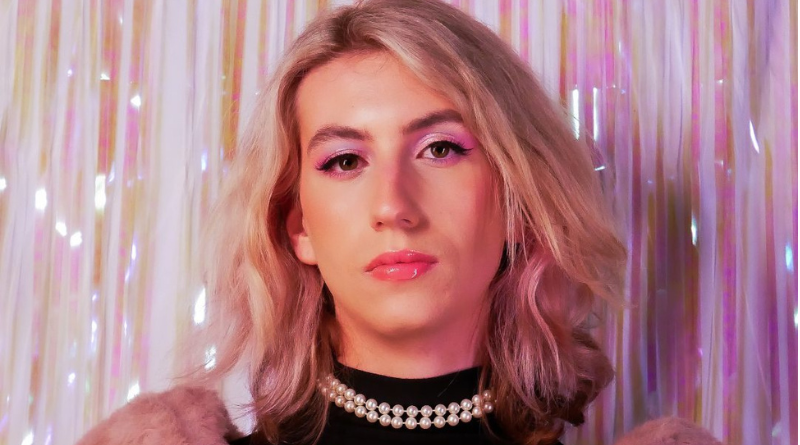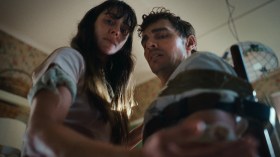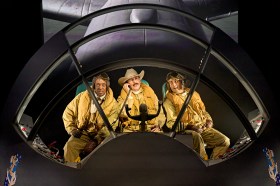Alice Maio Mackay is an 18-year-old transgender award-winning filmmaker based in South Australia. Her latest film, Satranic Panic, is having its world premiere this Thursday night at SXSW Sydney. For the average teenager, this would be a nerve-wracking event. But for Mackay it’s just another day on the job.
‘I dropped out of school when I was 16 to do filmmaking full time,’ she tells me. ‘Film is pretty much my whole life now’.
Officially Mackay’s fourth feature film, Satranic Panic focuses on friends Aria, a trans drag queen, and Jay, an artist. After a sinister cadre murders their mutual friend Max, they must confront a demon conspiracy that leads closer to home than they’d like. It’s a bloody, monster-infested road movie about the power of claiming one’s identity and the importance of chosen family. It’s campy, it’s colourful, and it absolutely rules.
Read: The Dreamlife of Georgie Stone: ‘I hope there’s more empathy for trans people’
Mackay started making films in primary school – mainly stop-motion animation using lego when she was ‘about twelve’, which means she has been an active filmmaker for over six years.
‘The first film festival I entered was with my stop motion film about a lego noir detective,’ Mackay reveals. ‘But back then I was just doing it for fun – now it’s serious’. And it shows: Mackay has a prolific CV of fully realised features and shorts, T Blockers (2023), Bad Girl Boogey (2022), and So Vam (2021) to name but a few. That’s an average of one feature film per year: keep that up and Mackay might just have a body of work one day to rival Alfred Hitchcock’s.
While she is an activist whose trans identity is – from an outside perspective at least – clearly woven into every narrative she produces, Mackay says she’s not consciously invoking the creative principle of ‘write what you know’.
‘I’m just making films that I want to see. I’m focusing mainly on what is fulfilling creatively and personally – the things I make have to meet that criteria because I sit with the story for so long.
‘Trans representation in cinema is very sanitised. It’s rare that there’s any at all, but then what we do get is so watered down – either that or it’s trauma porn.’
‘I want to explore trans characters through an honest, three-dimensional approach. That means not giving all the screen time to just the medical side of transitioning.’
While it’s been a thing of rarity in the past, trans directors and trans films are on the up and up, so Mackay is in certainly in good company. She even names Vera Drew, director of the copyright-dodging trans fantasy film The People’s Joker, among her peers: ‘She and I are close friends … she’s even editing my latest feature.’
Side note: The People’s Joker is screening, completely legally, at SXSW Sydney as well – and you should absolutely check it out.
Read: The People’s Joker: the wildest superhero movie you probably won’t watch
I’m forever curious about the links between gender identity, fringe cultures, and horror. Mackay and I apparently have this in common, but horror appeals to her because it’s ‘fun, gory, and campy’.
‘I grew up on stuff like Buffy the Vampire Slayer, which was the perfect amalgamation of girlhood, coming-of-age, teen friendship stuff, and those spooky horror elements,’ she says. ‘I love that combo because I can use it to tell stories about real, down-to-earth characters who all these interesting, over-the-top things happen to’.
‘People will always be drawn to horror,’ she says. ‘On the surface level, it’s just about having fun. But beyond that, there’s the element of monster-as-metaphor, which queer people can particularly relate to. We’re constantly “othered” by society, so the monster in horror is the perfect representation of that. I also think the genre is inherently queer. There are theories that Bram Stoker’s Dracula was about his own sexual oppression – because it’s possible he was a closeted queer man.’
Mackay’s favourite filmmaker is Gregg Araki, a queer American director best known for Mysterious Skin (2004) and White Bird in a Blizzard (2014) – two genre bending flicks with common themes of teenagers experience alienation and disenfranchisement. The influence on Mackay’s work is apparent. ‘I love his hyper-stylised worlds and authentic, uncensored queer stories,’ she says, ‘as well as the witty banter and sci-fi elements’.
Mackay wanted her film to be grounded, firstly, in a sense of realism, e.g. just two people hanging out before throwing in all the horror elements. ‘Like Friday the 13th Part Two, you know?’ she says. ‘That’s essentially just a hangout movie’. So, Satranic Panic film opens on Aria and Jay hanging out backstage, in their element – and then shit gets real weird.
Read: Best Australian horror films – top 20
Her ouvre of films is not just impressive because of her age – but also because of the limited finance options. Mackay works with tiny budgets – where the shoestring is more like the shoe aglet – and she’s not remotely put off by the restrictions that come with them. ‘Obviously I would like to get more money to make bigger films,’ she says, ‘but at the moment I’m making the films I want and that’s what matters.’
‘Satranic Panic is not necessarily the sort of film that would get made with big studio support anyway’.
After the film shows tonight at SXSW Sydney, Mackay tells me Satranic Panic will have screenings in LA and New York, before continuing on the festival circuit and then, finally, ‘coming out some time next year’. But alongside that Mackay is also finishing a Christmas movie (Carnage for Christmas is the title). No big deal.
Satranic Panic screens on 19 and 20 October 2023 at SXSW Sydney – entry is available to badge and pass holders only.





